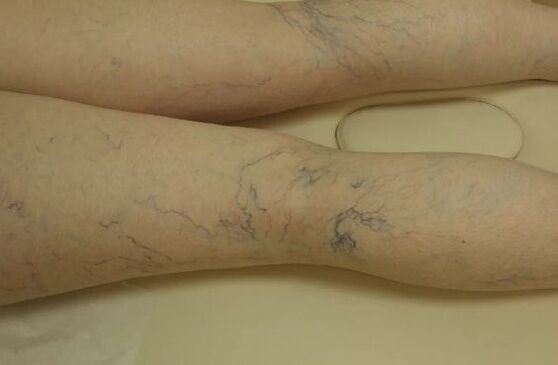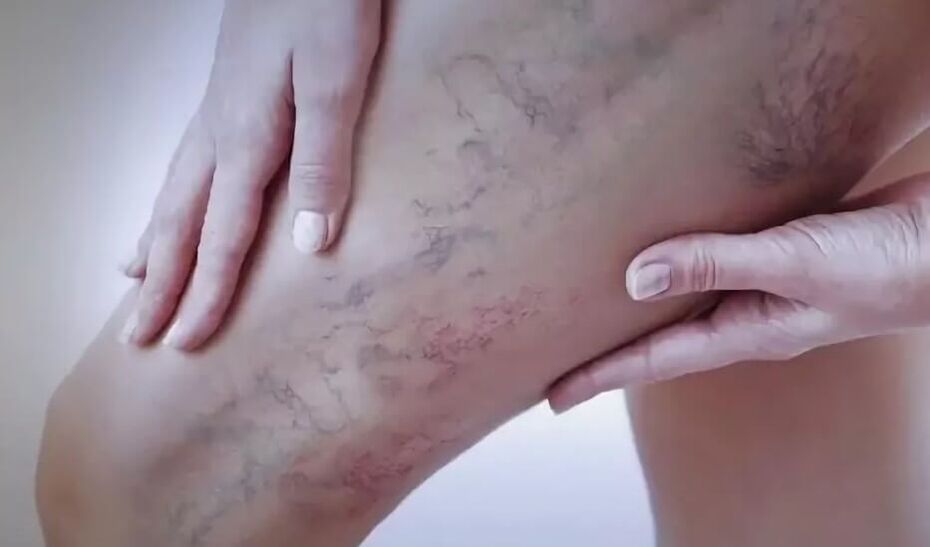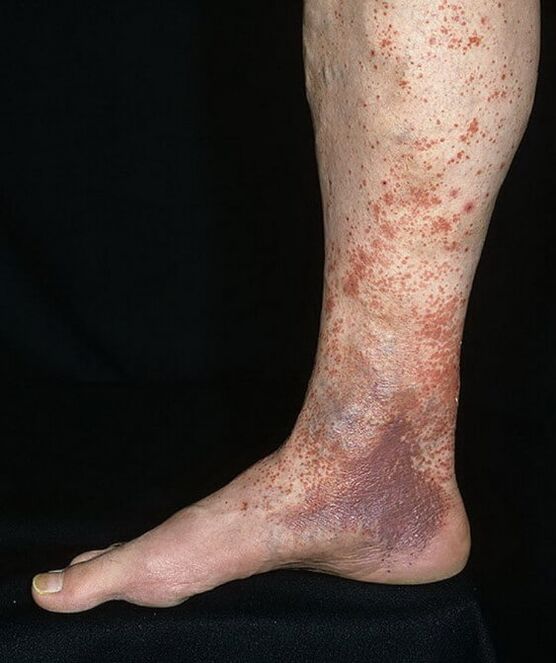Varicose veins on the legs are a chronic change in the outflow of blood, due to the influence of the mechanical, toxic, traumatic or other factor factor.
To better understand the essence of the pathological process, it is necessary to refer to anatomical information.
The lower limbs are provided with two main ways:
- On arterial branches.They transport oxygen rich blood, which only provides cells with useful compounds.
- Through the veins.The liquid tissue tolerates carbon dioxide and unnecessary substances for processing, in the reverse movement of the blood from the structures, the veins are involved.
It should be noted that different types of blood vessels are not connected or reported, the systems are completely closed.
Blood through the veins moves strictly in one direction.The muscle layer in these structures is rather weak, all the work falls on special valves.They are like partitions, doors that do not exceed the liquid fabric in the opposite direction from the application.
Against the background of greater venous pressure, injuries, damage and other factors, the valves weaken.The blood moves back, the load on the walls of the blood vessels increases.Vienna is consumed several times faster.
Under the mechanical effect, the composition structures change their properties and sizes.Varicosis itself begins.
This disease is characterized by deformations of the blood vessels, a decrease in their functional activity, protrusion similar to the aneurysm of the walls along the entire length.
Varicosis is dangerous as in time it leads to a break in the vein, the formation of blood clots, the death of local tissues.The treatment should start immediately, from the moment the pathological process is detected.
A characteristic characteristic of a disorder is a relatively without haste progression.The main contingent of patients are men and women over the age of 18.
Despite the relatively unhurried development, the disease behaves unpredictable.Never say in advance at what point will critical complications develop.
A doctor who treats the disease is a phlebologist.
Development mechanism
The pathological process is based on heterogeneous factors, if they are generalized and composed of an approximate framework, the options will be the following:
Mechanical influence
Increased physical activity on the veins of the legs.It is, for example, with intensive sports.The most common options are the characteristics of professional activity (manufacturers, teachers, cooks and others suffer), increase in body weight, since the load on the legs grows.
There are any possibility of overcoming the pathological process in time alone.The main thing is to eliminate the abnormal factor.
Traumatic lesions of the surrounding fabrics
Not the veins themselves, but the areas around.Bruises of soft structures, muscles, ligaments, partial and complete fractures.
There are two reasons for the development of varicose veins: compression of blood vessels with changed tissues and also irregular redistribution of the load on the lower limbs.
It is interesting to note that the culprits of varicose veins can also be diseases of the musculoskeletal system: arthritis and the like.
Compression of the legs of the legs
This refers to external flu.The violation of the bloodstream often causes patients themselves with their unreasonable actions.
For example, the use of tight tights or socks is interested.Particularly similar are women who are ready to put health in the search for beauty.
When compressing the legs of the region, which are below the compression site, they are subjected to stagnant processes.The venous-linen-off flow is significantly disturbed.This leads to rapidly progressive varicose veins.
There are cases in which the pathological process started later, years later from the negative influence.
Violations of hormonal balance
The disorders of the production of thyroid gland substances, adrenal glands and pituitary glands are affected.
Change can affect other compounds: Reproductive system hormones, androgens, estrogen.They partially regulate the tone of large ships, veins and arteries.
Genetic characteristics
The history infused, according to research, plays almost the main role in the development of the pathological process.This is not a trigger, but a clear premise that increases the probability several times.
Of course, the presence of a relative who suffered from varicose veins is not a guarantee of the development of the pathological process, but the probability is significantly higher.
It is necessary to adhere to the prevention rules in order to minimize risks.
Hypovitaminosis
For normal work, the regeneration of veins, arteries, ascorbic acid is required.In addition, the B vitamins, and, D. There can be no normal restoration of blood vessels without them.They consume quickly, lose their previous elasticity.
If the state of deficiency lasts long enough, for several months, in order not to avoid changes from the veins.
The disease develops faster than usual, progression towards a pronounced and dangerous phase takes only a few months, a maximum of a couple of years.
Anomalies of the congenital ship
The opinions, as a rule, do not develop in isolation.Other deviations can be found.Therefore, diagnostics has no problems.
Natural states
Pregnancy, severe birth, characteristics of the hormonal background in adolescence or closer to old age.
There are other mechanisms that are less common.For example, intoxication, exposure to the body of radiation and others.The most common are appointed.
Varicose veins are a disease characterized by a deviation system: vene deformations, aneurysm formation, stars, thinning of the internal coating.The influence of a group of pathogenetic factors is possible.
Classification
The methods of the unit refer to the stage of the pathological process, to its form.On all in order.
The technique adopted in medicine distinguishes three degrees of disease development:
- Compensated.The symptoms as such are absent, the patient does not make any complaints about health.The pathological process at the beginning of its development.But there are already visible signs: the dilated veins protrude through the thickness of the skin.For several years, the violation will go to a new phase.
- Subcompensation.The clinical signs of the varicose vessels are clearly expressed.Among these, you can distinguish pain, gravity in the legs, the feeling of managing goosebumps, weakness, convulsions at night.After rest, they come to nothing.There are also visible events.You can make a diagnosis without problems.
- Decompose.In addition to the symptoms already mentioned, additional: legislation of the legs, loss of sensitivity, common rash, constant areas of itching and burning of the lesion.
There are real risks of tissue necrosis, thrombosis.The treatment is urgent, otherwise - in order not to pass the disability.
Standing

There is an generally accepted international typing of the pathological process in the phases (classes):
- 0. The visible symptoms of the disorders are minimal.Patients speak of gravity in the lower limbs.This phase can last indefinitely.
- 1. The stars are formed on the surface of the legs, the veins are expanding and become clearly visible.The clinic is still the same.The maximum episodes of night kidnappings develop, which are interrupted with the same speed and suddenly when they started.
- 2. Clinical signs are identical.With a visual assessment of the lower limbs, the doctor reveals varicose changes visible from the veins: ramification, protrude, form complex deformations.
- 3. From this phase the pronounced edema begins.
- 4The skin above the surface of the lesion changes the shadow in the dark one, compact significantly and dries.It becomes thin, because any mechanical effect causes painful and deep combs.
- 5. Small erosions appear.
- 6. Complete trophic ulcers are being developed.
For the complete formation of the pathological process, from 0 to the sixth phase, it takes up to several decades.
Symptoms
The clinical picture depends on the disorder phase.If there is an average list of events, the list will be as follows:
- Heaviness in the legs.Above all, after a mechanical load, a long -term work day.Walking, standing in a place becomes problematic.Over time, the symptom intensifies only, which indicates the progression of the violation and allows you to suspect varicose veins in the very early phase.
- Intolerance to physical activity.Initially the patient is not able to walk for a long time, so standing.If you start a disorder, it will only worsen.A person will not be able to climb the stairs without long breaks, breaks.This is due to venous lymphatic stagnation in the expanded veins.
- Pain of different intensities.In the initial phase they are absent.So, after a few months or years, the severity of the event is growing.The stupid and uncomfortable sensations begin.
They intensify after physical activity, with a strong change in the position of the body.
 At the final stages of the disease, the symptom remains constantly with the patient, it does not disappear at all.
At the final stages of the disease, the symptom remains constantly with the patient, it does not disappear at all. - Visual changes from ships.They seem an abnormal branch, the formation of stars on the legs.These manifestations clearly indicate the beginning of the varicosis vessels.Therefore, diagnostics over time is becoming easier.It remains only to clarify the location of the changes and their degree.
- Swelling.They begin gradually, approximately with the second or third phase of the pathological process.First - by the end of the day.Passes after a night of rest.Therefore, volume variations are constantly preserved, they do not end at all.As a rule, the signs refer first, then the other leg.
- Dark cramps.The violation of the tone of the muscles, the cramps, is one of the first signs of varicose veins, which is due to the slowing down of the venous lymphatic outflow, the tricks of the tissues and cellular respiration.
Cramps in the legsThey prevail at night, accompanied by very serious pains.The patient cannot stay on the leg interested during the day, or even different.Gradually, the frequency of spasms becomes only higher.
- Itchy skin.A sign of alarm of the varicose veins, which characterize gradual dystrophic disorders.In the initial phase of erosion, there are still no ulcers.But this is a matter of time.
- Changing the shadow of the dermis.Hyperpigmentation.The darkening of the surface of the skin.Close to the final phase of the pathological process, the lower part of the leg acquires a rich tone of raspberry.
A characteristic symptom of the varicose veins of the lower ends is the seal of the skin above the lesion, which is associated with gross scars of tissues under the surface of the epidermis, the external layer of the skin.
- The formation of a rash.So called varicose dermatitis.This is an omen of the final phase of the pathological process.Little papules are very itchy, they do not allow the patient to live normally.Complications are possible, secondary infection of wound surfaces.
- Trophic ulcers.A clinical sign, which is characterized by the formation of large erosions, focal of tissue decay.First - superficial, then fiber of fat.And there is not far from the necrosis.Therefore, it is not possible to pull with the treatment.

The symptoms of varicose veins are caused by high tissue trophies, venous-linfatic outflow disorders, epidermal destruction and subcutaneous fat.
Clinical signs progress slowly, because there is any possibility to start timely treatment.The patient's task is not to lose an important point.
Profile specialists who must be contacted: phlebologist, dermatologist, hematologist.
Reasons
Varicosis develops following a combination of factors or influence of one, but a very intense provocateur.
There are several options:
- Physical activity.Long walk, standing still.Usually, such a moment is associated with the characteristics of professional activity, lifestyle.
- Injuries.Fractures, full or partial.Also bruises, damage to soft fabrics.
- Hypovitaminosis.The lack of substances of group B, and, D, ascorbic acid.
- Genetic factors.Hereditary moments, welcome family history.The probability of a pathological process increases, but there is no guarantee that the disease begins.
- Mositi against the background of hypothermia, physical overload.
- Arthritis.Joint inflammation.
- Hormonal imbalance.The joints of the thyroid gland, adrenal glands, pituitary glands are missing either in excess.
- Flebitis of the ship's ships.The cause of the varicose veins in inflammation of the infectious or non -pectical veins.
- Vasculitis of the vessels of the lower limbs.Autoimmune lesions.
- Pregnancy.Since the hormonal background changes and the load on the legs, the entire musculoskeletal system grows.
- Pertic period.Up to about 17-20 years.
- Menopause (Andropauza).Klimax.The gradual attenuation of the reproductive function.
The causes of varicose veins can be traumatic, inflammatory, degenerative, dystrophic.
Diagnostics
Flebologists are engaged in the exam.Only then, if necessary, are other specialists connected.Among the methods:
- Oral survey.The doctor must understand which complaints does the patient himself.
- Hang -up collection.The study of the probable origin of the problem.
- Visual evaluation of the status of the legs.As for, there is the opportunity to study the nature of the pathological process, its characteristics.
- Palpation.Physical technique.
- UZDG.Dopplerography of the ship's ships.It allows you to detect anatomical changes from the lower ends, deviations of the speed of the bloodstream.Used as the main methodology.It makes it possible to quickly make a diagnosis and study the degree of disorder.
- X -raggi.If there is such need.
- In particularly difficult cases, the doctor prescribes a magnetic resonance imaging.
The development of varicose veins on the legs is a sufficient and visually characteristic sign of expansion of the veins of the lower ends, it can be diagnosed on it.Subsequently, it remains to determine the severity of the pathology.
Treatment
The therapy in the initial stages is conservative.In total, three approaches can be distinguished.
Drug.Implies a systematic administration of drugs.Means that stimulate microcirculation, blood flow, valves, protect the vessels from further destruction of the tissues are prescribed.
Between groups of funds:
- Venotonic.
- Angioprotectors.
- Vitamins, antioxidants.
In addition, physiotherapy, exercise therapy, the massage are actively prescribed, it is shown to wear a compression knitwear.
A conservative technique is used in the initial stages of the disease or for auxiliary correction in the other main method.
A minimally invasive approach.The treatment of varicose veins of the lower ends involves the destruction of the affected vases using a special sclerosing drug, liquid nitrogen.
The methodology of sclerotherapy or radio frequency ablation is used in pronounced phases, but not critical of the disease.
Surgical approach.The treatment of varicose veins on the legs requires the use of laser, electric currents or direct excision of the vases concerned - Flebectomy.
The doctor removes half a structure, sews fine healthy areas, forming anastomosis.Very soon the blood flow is restored.
There are several operational techniques.The choice remains with the doctor.
Forecast
The varicose veins on the legs are completely treated in the first three phasesSo there are risks of complications, irreversible changes in the fabrics of the legs: ulcers, atrophy of the muscles and others.Although survival is still almost 100%.
Against the background of necrosis, common erosion, sepsis, the probability of death increases ten times.
In general, the disease is well treated.
Prevention
The preventive measures are very simple, the main thing is to adhere strictly to them:
- Divide.Every hour or two you have to crush.Especially with a sitting/standing lifestyle.
- Wear comfortable shoes, socks, tights.Preferably from natural materials.
- Use of compression knitwear.
- Light physical activity.Swim, run.The main thing is not overwhelmed.
- Adequate nutrition.More vitaminized products.
- Optimal consumption methods.1.5-2 liters per day.
The lack of fluid affects negatively, the blood is inspected, it moves worse through the pots, the pressure in the venous network increases.
Consequences
The complications can be fatal.Among the options:
- Muscle dystrophy.
- Paresis.Partial loss of sensitivity
- The formation of ulcers with the probability of secondary infection.
- Fabric necrosis.Gangrene.Especially with the defeat of the deep veins.
- Bomb of the legs of the legs, thrombophlebitis.
- Sepsis.Blood poisoning.
- Disability.
The varicose veins of the lower ends are a pathological change in the form, in the structure, in the elasticity of the legs of the legs (and not only) with the loss of muscle functions.
The disease develops slowly, but without quality treatment, the result will be deplorable.
























